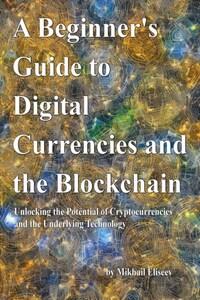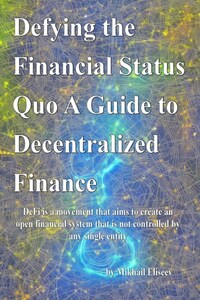Part 1. "Cryptocurrency 101: A Beginner's Guide to Digital Currencies and the Blockchain"
Welcome to A Beginner's Guide to Digital Currencies and the Blockchain! In this book, we will be exploring the world of digital currencies and the underlying technology that powers them: the blockchain.
You may have heard of popular digital currencies like Bitcoin and Ethereum, but there are many more out there that are gaining in popularity and adoption. Digital currencies offer an exciting new way to store and transfer value, and the blockchain technology that underlies them has the potential to disrupt and transform many industries.
However, the world of digital currencies and the blockchain can be confusing and overwhelming, especially for those who are new to the space. That's where this guide comes in. We will provide a comprehensive overview of what digital currencies are, how they work, and the various ways you can use them. We will also delve into the basics of the blockchain and how it functions, as well as some of the potential applications of this technology.
By the end of this guide, you should have a solid understanding of digital currencies and the blockchain, and be well-equipped to navigate this exciting and rapidly-evolving space.
Chapter 1: What Are Digital Currencies?
Digital currencies, also known as cryptocurrencies, are digital or virtual currencies that use cryptography for security and are decentralized, meaning they are not controlled by any government or financial institution.
One of the most well-known digital currencies is Bitcoin, which was created in 2009. Since then, hundreds of other digital currencies have been created, each with its own unique features and characteristics.
Digital currencies operate on a decentralized network, using technology called the blockchain. The blockchain is a distributed ledger that records all transactions on the network. It is decentralized because it is not controlled by any single entity, but rather is maintained by a network of computers working together.
Digital currencies offer several benefits over traditional fiat currencies (i.e. those issued and backed by governments). For example, they are often faster and cheaper to use for international transactions, as they bypass traditional intermediaries such as banks. They are also highly secure, as the use of cryptography makes it difficult for transactions to be altered or counterfeited.
Chapter 2: How Do Digital Currencies Work?
So, how do digital currencies actually work? Let's take a closer look at the process of sending and receiving digital currencies.
When you want to send a digital currency to someone, you create a transaction on the blockchain by specifying the recipient's public address and the amount of currency you want to send. You then sign the transaction with your private key, which is a unique code that only you have access to.
The transaction is then broadcast to the network, where it is verified by nodes (i.e. computers) on the network. These nodes check to make sure that the transaction is valid (e.g. that you have sufficient funds to make the transaction) and then add it to the blockchain.
Once a transaction is added to the blockchain, it is considered to be complete and cannot be altered. This ensures that the transaction is secure and cannot be tampered with.
When the recipient receives the digital currency, they can use their private key to access it. They can then either keep it in their digital wallet or exchange it for other currencies or goods and services.
Chapter 3: How to Use Digital Currencies
Now that you have a basic understanding of how digital currencies work, you may be wondering how you can use them in your everyday life. There are several ways you can use digital currencies, including:
Buying goods and services: Many businesses, both online and offline, now accept digital currencies as a form of payment. You can use your digital currency to purchase a wide range of goods and services, from coffee to plane tickets.
Investing: Some people choose to hold onto their digital currencies as an investment, hoping that their value will increase over time. Digital currencies can be highly volatile, so it's important to do your research and understand the risks before investing.
Sending money internationally: Digital currencies offer a fast and cost-effective way to send money internationally, as they bypass traditional intermediaries such as banks.
Earning rewards: Some companies and organizations offer rewards or incentives in the form of digital currencies for completing certain tasks or contributing to their projects. For example, you may be able to earn digital currency for participating in online surveys or for contributing to an open-source software project.
Chapter 4: The Different Types of Digital Currencies
As mentioned earlier, there are hundreds of different digital currencies in existence, each with its own unique features and characteristics. Here are a few examples of the different types of digital currencies you may encounter:
Bitcoin: Bitcoin is the original and most well-known digital currency. It is decentralized, meaning it is not controlled by any government or financial institution.
Ethereum: Ethereum is a digital currency that also has a built-in programming language, allowing users to build and run decentralized applications (dApps) on top of the Ethereum blockchain.
Litecoin: Litecoin is a digital currency that is similar to Bitcoin but with faster transaction times and lower fees.
Ripple: Ripple is a digital currency that is primarily used by banks and financial institutions to facilitate international payments.
Monero: Monero is a digital currency that is focused on privacy, as it uses advanced cryptographic techniques to ensure that transactions are untraceable.
Chapter 5: The Basics of the Blockchain
As mentioned earlier, the blockchain is the technology that underlies digital currencies and allows them to function. But the blockchain has many other potential applications beyond just digital currencies.
At its core, the blockchain is a decentralized, distributed ledger that records transactions on multiple computers. This means that there is no central point of control or vulnerability, making it highly secure.
One of the key features of the blockchain is that it is immutable, meaning that once a transaction is recorded on the blockchain, it cannot be altered. This ensures that the transaction history on the blockchain is accurate and transparent.
The blockchain is also transparent, as all transactions are visible to anyone with access to the network. This makes it easy to track and verify transactions, which can be useful for a variety of applications such as supply chain management and voting systems.









